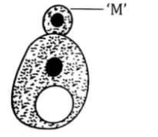EASY
Earn 100
A protozoan reproduces by binary fission. What will be the number of protozoans in its population after six generations?
(a)
(b)
(c)
(d)
50% studentsanswered this correctly
Important Questions on Modes of Reproduction
EASY
MEDIUM
MEDIUM
Statement I: The binary fission of Euglena is called homothetogenic fission because the daughter euglenae are like mirror images.
Statement II: Binary fission in Paramecium is known as perkinetal fission because it occurs at right angles to the kineties.
MEDIUM
Statement In ciliates, conjugation restores the vigour and vitality which are lost due to chromosomal imbalance in the macronuclei due to repeated amitotic divisions.
Reason Conjugation is temporary union of senile ciliates belonging to same mating types. It often prevents exchange of nuclear material.
EASY
Identify the asexual reproductive structure in the following diagram:

MEDIUM
(i) During favourable conditions Paramecium stops feeding after attaining its maximum growth.
(ii) At first the micronucleus divides by amitosis and the macronucleus divides into two daughter nuclei by mitosis.
(iii) The proter receives the anterior contractile vacuole, cytopharynx and cytostome from its parent individuals.
(iv) Before karyokinesis a transverse constriction appears in the middle of the body.
EASY
EASY
EASY
MEDIUM
MEDIUM
EASY
EASY
Match the following
| List-I | List-II | ||
| (A) | Longitudinal binary fission | (I) | Paramoecium |
| (B) | Transverse binary fission | (II) | Amoeba |
| (C) | Sporogony | (III) | Pleurobrachia |
| (D) | Sporulation | (IV) | Plasmodium |
| (V) | Euglena |
MEDIUM
EASY
EASY
MEDIUM
EASY
EASY

